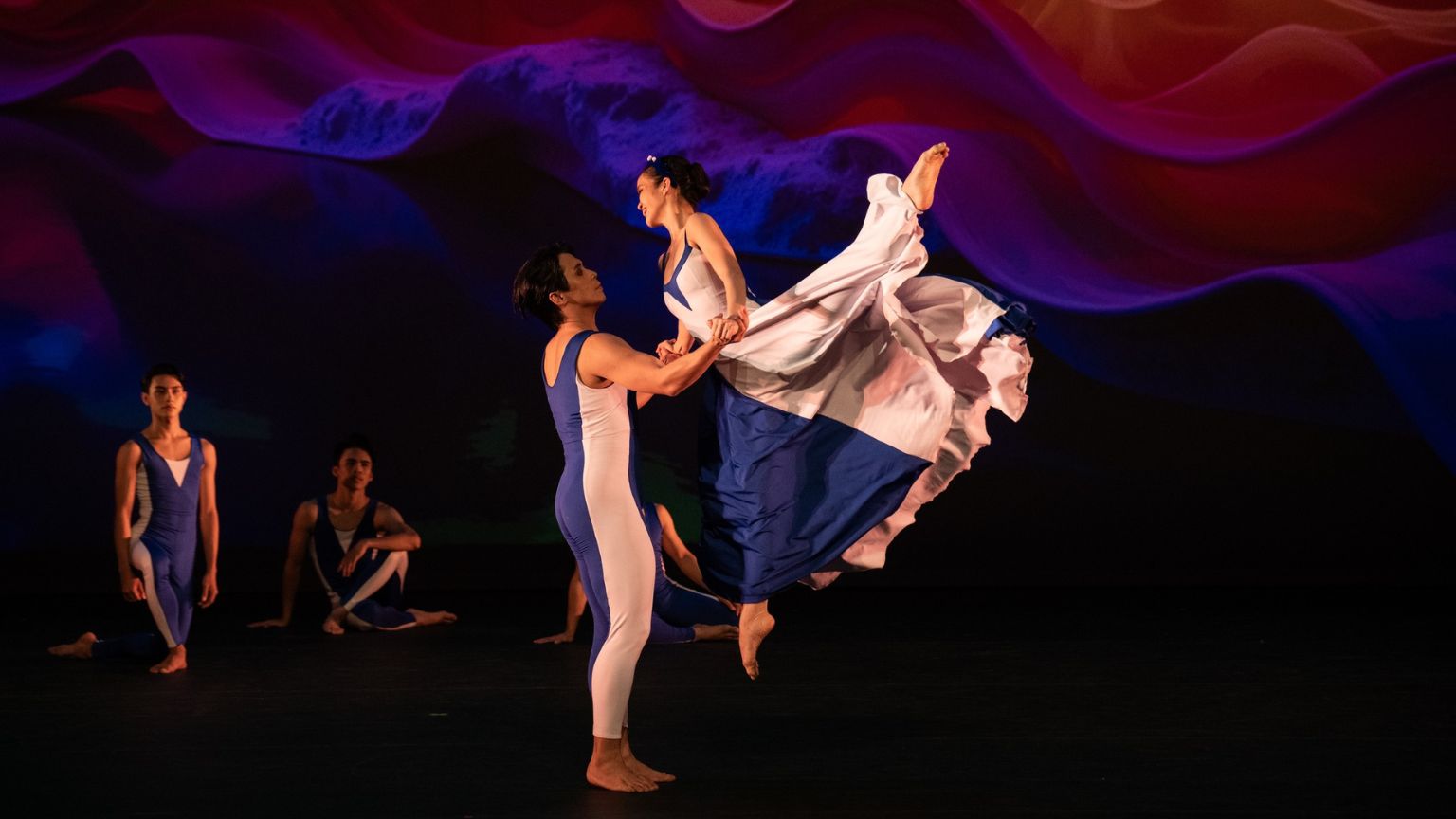
REVIEW: Alice Reyes Dance Philippines (ARDP) Bridges Generations with ‘Pasasalamat’ at Rockwell’s New Stage
The new Proscenium Theater in Rockwell opened to a house packed with dancers, patrons, and National Artists, but it was Alice Reyes Dance Philippines (ARDP) that put the stage through its paces. The program, billed simply as “Pasasalamat,” suggested gratitude, yet what unfolded was something more—a layered evening tracing the company’s DNA of presenting three generations of choreographers. Longtime followers had been clamoring for something beyond the canon of National Artist Alice Reyes’ works, and this performance answered with a refreshing commitment to choreographic craft.
At 91, choreographer and educator Norman Walker returned to the company with two works steeped in the ethos of Martha Graham, embracing weight, suspension, grounded strength and lyricism that shaped Reyes’ CCP Dance Workshop in the early ’70s. In contrast, former Ballet Philippines artistic director Augustus “Bam” Damian III offered an abstract ballet that echoed contemporary European sensibilities—deconstructing classical lines with seamless shifts between sharp, percussive bursts and soft, unbroken phrases. Two younger voices, Erl Sorilla and Monica Gana hinted at their individuality, a subtle nod to the future.
Emerging Choreographers
In “Mga Kuwento ni Juan Tamad,” choreographer Erl Sorilla transforms a beloved figure from Philippine folklore into a dance-theater that is as witty as it is affecting. Toto Sorioso’s music and lyrics carry the narrative, complemented by the vibrant sets and costumes of Loy Arcenas. In this modern retelling of the Filipino folktale, the famously indolent hero is tasked with retrieving a golden coconut from a fearsome crocodile to win the hand of his love interest Maria Masipag and the approval of her parents. What unfolds is a satirical yet heartfelt journey of transformation, as Juan—guided by a wise turtle, a bird, and his loyal monkey companion Matsing—learns the virtues of determination, compassion and courage. Along the way, he rescues a mythical creature known as the Paboreal and ultimately defeats the crocodile, returning home not just with the prize but as a changed man.

Ricmar Bayoneta as the titular role in Mga Kuwento ni Juan Tamad; Photo Credit: Erica Feliz Marquez-Jacinto
Sorilla’s dancers inhabit roles. Each gesture, glance, and shift of weight is fine-tuned for comic and emotional precision. Displaying his theatrical instincts with unflagging zeal, Ricmar Bayoneta made a winning Juan Tamad, infusing the role with a sly charm and comic timing that drew chuckles without slipping into caricature. We were told that Dan Dayo had suffered an injury during the dress rehearsal, forcing the cancellation of the much-anticipated solo, Walker’s “Satan’s Soliloquy.” Even so, Dayo appeared as the Matsing, bounding across the stage with manic energy and irrepressible humor, a show of his grit and buoyant spirit. As the villainous Buwaya, Ejay Arisola, nearly swallowed by a heavy costume and its wagging tail, proved a sturdy partner to the dramatic Francia Alejandro as the resplendent Peacock, and later, a fierce combatant in his showdown with Juan. John Ababon brought quiet wit to the slow-moving Pagong, while Monica Gana, as the Kuneho gave a buoyant reading of the role, her rebounding jumps and springy phrasing suggesting mischief.
The choreographer’s take on “Juan Tamad” is so effective because of its clarity of intention and fluency in both form and feeling. The narrative arc—from comic sloth to hard-won heroism—is realized through encounters with animals who personify values. By the time Juan confronts the fearsome Buwaya and claims the golden coconut, the dance has subtly traced a moral awakening. Sorilla honors folk tradition, animating it with humor, movement, and a sincere belief in the possibility of change.
Monica Gana makes her choreographic debut with “Para kay Gabriela,” set to music by Angelo Favis. The duet of Gabriela and Diego Silang is brief, its simplicity deliberate. Gana favors clarity over embellishment, evoking the 19th-century milieu through Favis’ guitar strains and a sprinkling of folkloric steps at the start. The choreography breathes with tenderness: Gabriela moves toward Diego, her joy shimmering in each step, before he lifts her high into the air, dips her to the floor, and draws her into a sweeping circle around his waist.

Krislynne Buri (Gabriela), Renzen Arboleda (Diego); Photo Credit: Erica Feliz Marquez-Jacinto
Krislynne Buri moved with delicate precision, showing it in every measured gesture, while Renzen Arboleda was an eloquent presence and an attentive partner.
Deconstructivist
When Bam Damian’s abstract ballet “” was first presented, audiences responded that they couldn’t get enough of it. The title, loosely translated as “This is how it is,” seemed like a confident reply to that reaction. Set to the propulsive rhythms of Rene Aubrey, the work displays Damian’s command of choreography—slick, intricate, and compelling in its athleticism –done on pointe.
The original version opened with the dancers in unison, upright and poised in classical ballet positions. But as the music’s percussive layers deepened, the choreography broke into sharper contrasts. The limbs moved with striking clarity—legs piercing through space, torsos contracting inward, arms slicing at angles. The women’s movements became increasingly jagged, while the men, in contrast, spiraled with tension, their bodies carving broad convex and concave shapes through the air. Damian’s ear for music translated visually; the dancers’ kicks rose and fell in counterpoint to the descending notes of the score.
In this expanded version, the structure unfolds with compositional fluency. It starts with a female solo, followed by a male solo, then transitions into a sequence with the women dancing as a group, later joined by the men. Partnering sections introduced physical risk and daring: women flung themselves toward their partners in suspended arcs, caught midair in wrap lifts, overhead sweeps, and wide, pendular swings. The men danced with ease and abandon, their buoyant steps aligning naturally with the music. Throughout, the dancers moved with clarity, ease and precision.

C’est la Cie; Photo Credit: Erica Feliz Marquez-Jacinto
Damian’s ensemble embraced a stripped-down aesthetic—all-white costumes, no heightened facial expressions, no overt emoting. The emotion resided in the movement itself, attuned to the pulse of the music.
Master Craftsman
Choreographed in 1973 with Nonoy Froilan and National Artist Alice Reyes in the leads, Norman Walker’s “Songs of a Wayfarer,” set to Gustav Mahler’s anguished song cycle, unfolds the story of a wanderer tormented by unrequited love. On the day his beloved marries a wealthy suitor, he leaves town and dreams beneath a linden tree of a life that can never be. The choreography hints at the text without literalism, except in one haunting moment: the wayfarer, sprawled on the floor, lifts the woman as she whirls her hair across his face — a gesture that feels drawn directly from Mahler’s lament. Walker roots the drama in human longing rather than operatic gesture, giving shape to a love undone by class and family expectations. In the final tableau, she opens the tree to receive his spirit, a poetic “what if” that transcends the bleak reality of separation.
Ejay Arisola, usually stoic in rehearsal, surprised with a performance of unexpected dramatic sweep, his supple frame shaping phrases that evoked the fluidity of classic modern dance. Erl Sorilla, as the groom, offered a grounded counterpoint to Monica Gana’s luminous bride, her movement unfolding with an open, generous heart.
Walker’s new ballet “Seraphic Fire,” set to Ernest Bloch, develops into four luminous sections that chart the shifting moods of angels. It opens with a surge of grandeur in “Heroic Cosmos,” where the seraphims stride across the stage with solemn authority, their presence commanding and immense. “Waves of Creativity” turns inward, a hushed meditation punctuated by a sudden swell of ensemble force, recalling the earlier blaze. In “Water and Fire”, contrasting duets between male and female angels suggest polarity without passion, the central male figure poised and statuesque, flanked by serene attendants. The mood lifts in “Playground for Angels”, a buoyant finale of leaps and airy exchanges that radiate celestial ease.

Seraphic Fire; Photo Credit: Erica Feliz Marquez-Jacinto
“Seraphic Fire” reveals Walker as a meticulous craftsman and a deeply musical choreographer. His steps don’t just fill space—they animate the score, making Bloch’s music visible in arcs and pulses. Lines, circles, and diagonals shift with purpose, formations dissolving and reforming in seamless transitions that guide the eye from sweeping ensembles to intimate clusters. Spacing becomes drama, proximity suggesting harmony or contrast. Nothing feels arbitrary—each pathway, each level change, follows the music’s breath.
The choreography bears the hallmarks of the Martha Graham style—the body spirals, the shifting weight, the tilts, the bison leaps. The forward swoon sends a full skirt flying in a high arc, a signature Graham image that finds new resonance here. Walker designed the costumes as extensions of the choreography, their flowing skirts catching air and light, amplifying each turn and fall so that fabric becomes as eloquent as the dancers themselves.
If anything dulled the glow, it was the lighting—spotlights drifting away in “Juan Tamad,” brightness clashing with the lyric about nightfall in “Songs of a Wayfarer,” and the quiet romance of “Alay Kay Gabriela” lost in a flat wash. Yet through shadows and glare, ARDP’s artistry shone—proof that light, in the end, comes from the dancers themselves.
Tickets: Free, by invitation only
Show Dates: August 1, 7 PM
Venue: Proscenium Theater
Running Time: approximately 2 hours (with a 15-minute intermission)
Creatives: Ronelson Yadao (artistic director)
Mga Kuwento ni Juan Tamad: Erl Sorilla (book and choreography), Toto Sorioso (music and lyrics), Loy Arcenas (set and costume design), Barbara Tan-Tiongco (lighting)
C’est La Cie: Augustus ‘Bam’ Damian III (choreography and costume design), René Aubry (music), Barbara Tan-Tiongco (lighting)
Songs of a Wayfarer: Norman Walker (choreography and costume design), Gustav Mahler (music), Teddy Hillado (original lighting design), Barbara Tan-Tiongco (lighting)
Para Kay Gabriela: Monica Gana (choreography and costume design), Angelo Favis (music), Ejay Arisola (costume design), Lester Reguindin (costume design), Barbara Tan-Tiongco (lighting)
Seraphic Fire: Norman Walker (choreography and costume design), Ernest Bloch (music), Barbara Tan-Tiongco (lighting)
Cast:
Mga Kuwento ni Juan Tamad: Ricmar Bayoneta (Juan Tamad), Dan Dayo (Matsing), Karla Santos (Maria Masipag), John Ababon (Father Masipag), Cielo Inday (Mother Masipag), John Ababon (Pagong), Monica Gana (Kuneho), Ejay Arisola (Buwaya), Francia Alejandro (Paboreal), Krislynne Buri, Renzen Arboleda, Crizza Urmeneta, James Galarpe, Cheska Vasallo, Francine Beltran, Darylle Odejar, Karen Audal, Arnel Sablas (taumbayan)
C’est La Cie: Monica Gana, Karla Santos, Francia Alejandro, Crizza Urmeneta, Cheska Vasallo, Francine Beltran, Cielo Inday, John Ababon, Ejay Arisola, Renzen Arboleda, Ricmar Bayoneta, Erl Sorilla, James Galarpe
Songs of a Wayfarer: Ejay Arisola (Young Man), Monica Gana (Bride), Erl Sorilla (Groom), Karla Santos, Francia Alejandro, Crizza Urmeneta, Cheska Vasallo, Cielo Inday, Francine Beltran, Karen Audal, John Ababon, Renzen Arboleda, Ricmar Bayoneta, Dan Dayo, James Galarpe, Darylle Odejar, Arnel Sablas
Para Kay Gabriela: Krislynne Buri (Gabriela), Renzen Arboleda (Diego)
Seraphic Fire: Monica Gana, Karla Santos, Francia Alejandro, Crizza Urmeneta, Cheska Vasallo, Francine Beltran, Cielo Inday, Karen Audal, John Ababon, Ejay Arisola, Renzen Arboleda, Dan Dayo, Ricmar Bayoneta, Erl Sorilla, James Galarpe, Arnel Sablas


Comments